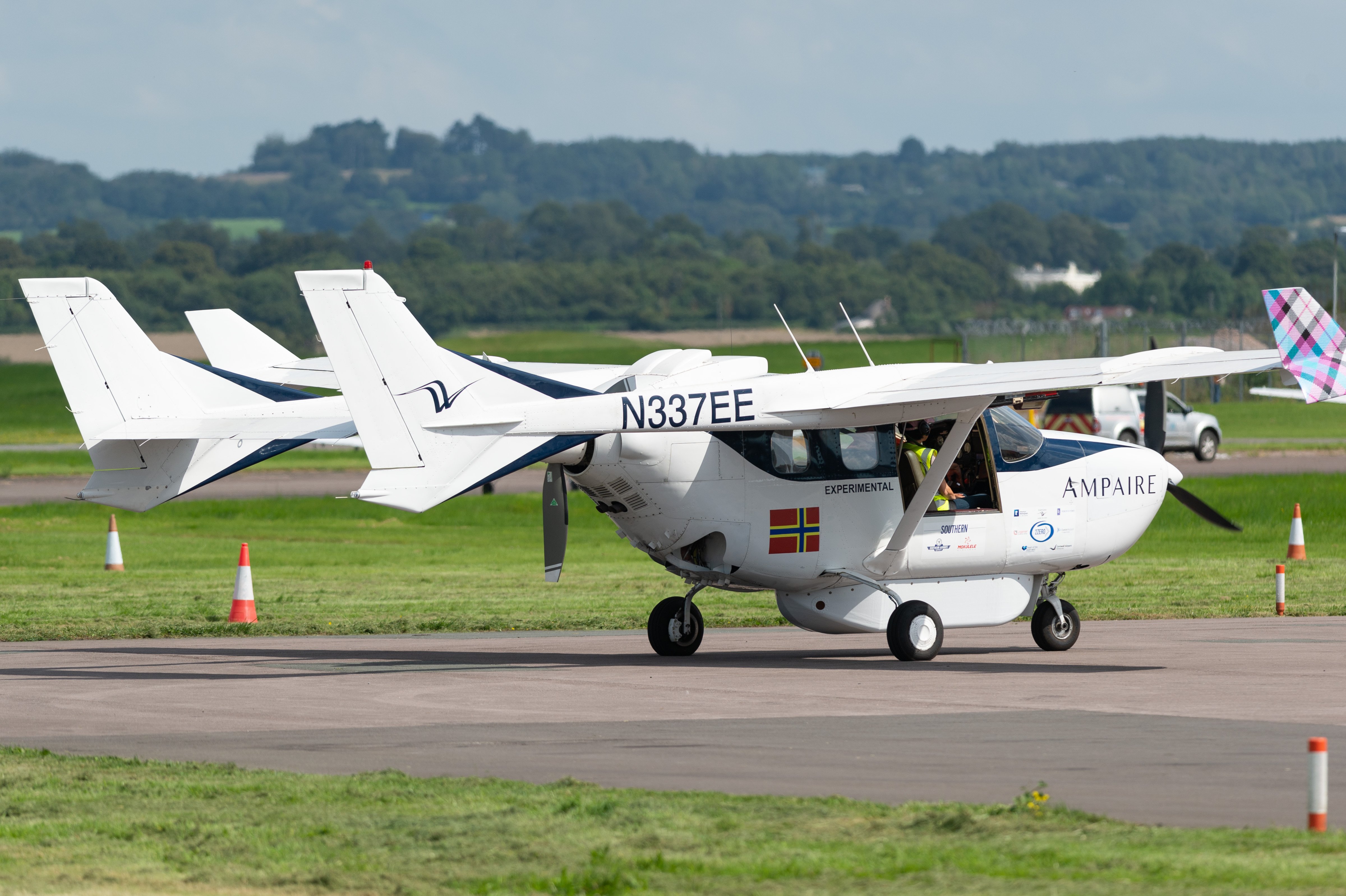Click Here to View This Page on Production Frontend
Click Here to Export Node Content
Click Here to View Printer-Friendly Version (Raw Backend)
Note: front-end display has links to styled print versions.
Content Node ID: 419176
Ampaire this week started the next phase of its UK-based flight trials for its plans to convert regional airliners to hybrid-electric propulsion. The company’s Electric EEL technology demonstrator is operating between Exeter Airport and Cornwall Airport Newquay to evaluate operational needs for commercial services that the company says could start by 2024.
The trials, using a converted six-seat Cessna 337 Skymaster, are part of the UK government-backed 2Zero program (Towards Zero Emissions in Regional Aircraft Operations), which is evaluating the case for hybrid-electric flights out of the southwest of England. They follow a series of flights conducted earlier this month in northern Scotland as part of the Sustainable Aviation Test Environment project, which is backed by the UK’s Industrial Strategy Challenge Fund.
Ampaire’s senior vice president for global operations, Susan Ying, said that the company is now ramping up efforts to bring multiple converted nine- to 19-seat aircraft to market. It is also in the early stages of designing a new clean-sheet hybrid-electric 19-seater model.
At the top of Ampaire's agenda is a plan to secure a supplemental type certificate (STC) for the 19-passenger DHC-6 Twin Otter, which it will market under the brand name EcoOtter SX. Ying also revealed that her company views the nine-seat Britten Norman BN-2 Islander twin-piston as a strong candidate for launching short sub-regional scheduled services.
The California-based company is using the Electric EEL to complete the development of its three-module electric propulsion system (EPS), which consists of an electric motor, a power inverter unit, and a set of batteries. On the converted Skymaster, this system drives a single propeller at the front of the aircraft, while a Continental IO-550 piston engine, mounted on the rear of the aircraft, acts in the original pusher-configuration role.
Ying told FutureFlight that once development work on the EPS is complete it will likely take another two years to complete the STC process for aircraft like the TwinOtter and the Islander. Much of this work will be handled by Ampaire’s six-member team in the UK, which is led by Andrew Rae, a professor of experimental and applied aerodynamics at Scotland’s University of the Highlands and Islands.
In addition to cutting emissions from jet-A-burning engines, the company says, it can also deliver 30 percent reductions in operating costs, which would support a business case for new scheduled services between smaller airports. Ying told a media briefing at Exeter Airport that the existential challenges faced by regional airlines during the Covid crisis have made it even more imperative to drive down operating costs while also making short-haul services environmentally sustainable. “It’s not enough to just demonstrate that the [hybrid-electric] propulsion technology works,” she stated. “You’ve got to be able to show that it’s economically feasible and that the operational aspects are as well.”
Proving the operational feasibility of hybrid-electric fleets is a key aspect of Ampaire’s flight trials in the UK, building on work it did last year in Hawaii with regional operator Mokulele.
Working with airport and airline partners, Ampaire has been focusing on factors such as recharging batteries during fast ground turnarounds, which in small airfields on Scottish islands can be limited to between four and 10 minutes.
At Exeter Airport, Ampaire is pricing out three potential solutions to make recharging electric aircraft efficient and economically viable. These include installing direct charging stations using renewable energy sources to connect directly with the aircraft; a process for charging sets of batteries that would then be used to recharge aircraft batteries; and arrangements for rapidly swapping out batteries while aircraft are on the ground. The company’s engineering team is also working on plans to design a series of batteries specifically for aviation use rather than depending on hardware developed for road vehicles.
Ampaire is part of the UK-based 2Zero consortium, which was set up to explore regional aviation electric flight solutions. In 2020, it received £2.4 million from the government-backed UK Research and Innovation (UKRI) agency’s Future Flight Challenge fund to supplement around £5 million that the partners are investing themselves. The other partners include Exeter Airport, Cornwall Airport Newquay, Rolls-Royce Electrical, regional carrier Loganair, the University of Nottingham, the Heart of the Southwest Local Enterprise Partnership, and UK Power Network Services.
Rolls-Royce is working on a new battery system that could be swiftly swapped while aircraft are between flights. The aircraft engine maker is also working on a thermal management system for the EPS with a focus on reducing weight.
Lord Callanan, undersecretary of state, minister for business, energy, and corporate responsibility at the Department for Business, Energy, and Industry Strategy, told reporters that the UK government is targeting carbon-neutral domestic flights by 2040 as part of a wider goal to decarbonize the whole air transport sector by 2050. When the UK hosts the COP26 climate change conference in October, the government intends to announce a wider consultation on these plans.
After completing flights between Scotland’s Orkney Islands and Wick on the mainland, the Electric EEL made a 481-mile flight from Perth to Exeter on August 23. This broke Ampaire’s previous record for the longest hybrid-electric sector of 341 miles, which was flown in October 2020 between Los Angeles and San Francisco.
Ying told FutureFlight that Ampaire, which earlier this year was acquired by U.S.-based air mobility platform Surf Air, intends to work directly with prospective operators of converted aircraft like the Twin Otter and the Islander to switch fleets to hybrid-electric propulsion. In some instances, it may choose to partner with established maintenance, repair, and overhaul organizations.
